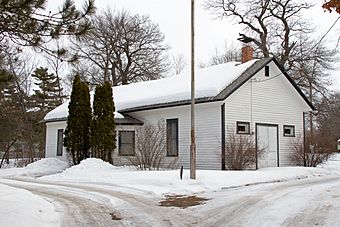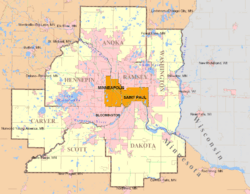Crescent Grange Hall No. 512 facts for kids
Crescent Grange Hall #512 is an old meeting place for a farming group called the Grange. It is located in Linwood Township, Minnesota. The hall was built between 1881 and 1882 by a local chapter of the State Grange of Minnesota. This was the first state-level part of the National Grange.
The hall was added to the National Register of Historic Places in 1979. It is important because it shows how farming and community life were in the area. It is also a well-preserved example of an early meeting hall built by a local Grange group.
Why the Grange Was Formed
Crescent Grange Hall #512 came about after the American Civil War. This time was known as the Reconstruction era in Minnesota. During this period, people living in rural areas faced tough economic times. Farmers especially struggled with high interest rates and an unstable economy.
After the Civil War, farmers in the South tried new ways to farm, like sharecropping. Farmers in the West saw their crop prices drop. Many farmers ended up owing a lot of money to bankers and merchants. These lenders often charged very high interest rates. On top of that, railroads and food companies charged high fees to transport goods.
In 1866, the U.S. Department of Agriculture sent Oliver Hudson Kelley to check on farmers. Kelley was a successful farmer from Elk River, Minnesota. He noticed that farmers often felt lonely and isolated on their farms.
To help with this, Kelley and six friends started the National Grange. It was also called the Order of the Patrons of Husbandry. Both men and women could join this group. Kelley's message to farmers was simple: join together to become stronger. He believed they could get better prices for their crops by working together.
Kelley wanted farmers to form cooperatives. These were groups where farmers could store and sell their crops together. This way, they could compete against middlemen who charged high fees. In 1869, he started the State Grange of Minnesota. This was the first state-level Grange group. By 1875, the national Grange had grown to 858,000 members.
Building the Hall
The Crescent Grange #512 group in Anoka County started in Linwood Township in 1874. Before they had their own building, members met in churches or at the homes of founding members.
On February 23, 1881, a meeting was held at J. G. Green's home. At this meeting, L.O. Tumbler suggested building a hall that was 32-by-20-foot (9.8 by 6.1 m). J. G. Green offered to give the land for the building, and everyone agreed.
On March 25, 1881, Grange #512 members gathered to cut pine wood from a nearby forest. The men took the wood to George Haskell's sawmill near Typo Lake. There, they cut it into lumber for building. Construction officially began in early June in Anoka County. Members who missed working on the project during the summer had to pay a one-dollar fine. During this time, the original building plans were changed to make sure there was enough kitchen space.
Crescent Grange Hall #512 had its first big celebration on July 4, 1882. However, work on the building continued until 1884. The hall is a single-story building, 46-by-20-foot (14.0 by 6.1 m) in size. It has a gabled roof and clapboard siding on the outside. Inside, there is a meeting room, an auditorium, and a kitchen.
In 1916, a Grange member named W.W. Wittig added more details to the hall. He created small recessed areas, called alcoves, on each side of the building. The front alcove became the main entrance. The one in the back had pretty stained glass windows. Later, in 1949, the ceiling was lowered. This was done to help save heat and make the sound better inside the hall.
What the Hall Was Used For
The hall was a very important place for farmers in the late 1800s and early 1900s. It was used to teach them the best ways to farm. Members could also share equipment that the group owned together. This included a threshing machine (used to separate grain) and a saw. They also used a barn space for storage and for social events for the Grange community.
By the early 1900s, the Grange Movement was still strong. It had lasted longer than other groups like the Farmers' Alliance. The Farmers' Alliance had pushed for more political action and helped start the People's Party. The Grange focused more on education and community support for farmers.
See also
- List of Grange Hall buildings
- National Register of Historic Places listings in Anoka County, Minnesota





